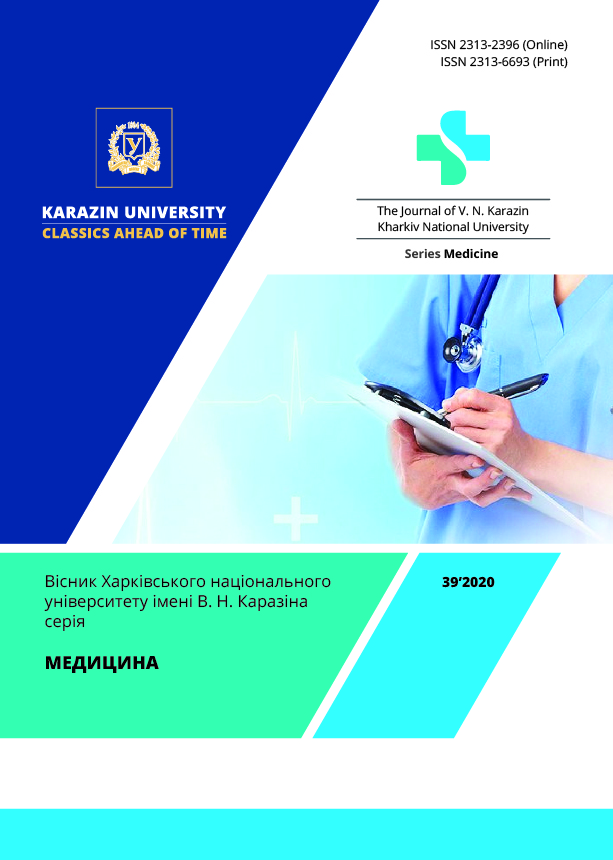Polymorphism of clinical phenotypes and heterogeneity of autoimmune targets of myasthenia gravis
Abstract
Abstract. The aim of the study was to evaluate the presence of autoantibodies to different subunits of nAChR and nuclear antigens at different myasthenia phenotypes. The work has investigated the presence of antibodies to α1- and α7-subunits of nAChR, the repertoire and frequency of occurrence of antinuclear autoantibodies in different clinical phenotypes of myasthenia to understand the mechanisms of pathogenesis of various forms of the disease. Additional factors of autoimmunization were identified that affect certain mechanisms of pathogenesis in thymus-independent and thymus-dependent myasthenia gravis. Autoantibodies to α1 and α7 subunits of nAChR were detected in case of thymus-independent myasthenia gravis and thymus-dependent myasthenia gravis with thymus hyperplasia or locally spread thymoma, as well as the presence of antinuclear antibodies in case of thymoma on the background of myasthenia gravis. Autoantibodies to the α1 subunit of nAChR are available in all patients with thymus-independent and thymus-dependent myasthenia gravis; the maximum titer was in patients with myasthenia and thymus hyperplasia. The presence of autoimmune antibodies to another target – to the α7 subunit of nAChR was found in patients with thymus-independent myasthenia gravis and with myasthenia and thymus hyperplasia. Detected anti-nuclear antibodies (ANA) in patients with thymoma, are preferably antibodies to structures that are directly involved in mitotic cell division, that is to centromere, to centromeric protein F, to the centrosomal protein of achromatin spindle – NuMa and MSA-2 antigen mitotic spindle that affects the course of cell proliferation, reparative and regenerative processes in tissues. The selectivity of antibody damage by the subunit of NAHR in different myasthenia phenotypes and the presence of ANA in thymus-dependent myasthenia with thymoma has great diagnostic and prognostic value. The presence of specific autoantibodies to certain nuclear structures of the cell, along with other autoimmunization mechanisms, affects various metabolic mechanisms and can be used to select targeted therapy taking into account individual pathogenic targets of the autoimmune process.
Downloads
References
Klimova, E. M., Lavinskaya, E. V., Minukhin, D. V., Syrovaya. A. O., Drozdova, L. A., Samoilova, A. P., Makarov, V. V., Makarov, V. A., Lukianova, L. V. (2017). On Forming Central and Peripheral Markers of Self-Tolerance Loss in Diverse Clinical Myasthenic Phenotypes. Scholars Research Library/ Der Parmacia Lettre, 9 (6), 8–17. Retrieved from https://www.scholarsresearchlibrary.com/abstract/on-forming-central-and-peripheral-markers-of-selftolerance-loss-in-diverse-clinical-myasthenic-phenotypes-12424.html.
Drachman, D. B. (1994). Myasthenia gravis. N. Engl. J. Med, 330, 1797–1810. DOI: 10.1056/nejm199406233302507.
Meriggioli, M. N., Sanders, D. B. (2012). Muscle autoantibodies in myasthenia gravis: beyond diagnosis? Expert Rev. Clin. Immunol, 8(5), 427–438. DOI:10.1586/eci.12.34.
Romi, F., Skeie, G. O., Gilhus, N. E., Aarli, J. A. (2005). Striational antibodies in myasthenia gravis: reactivity and possible clinical significance. Arch. Neurol, 62 (3), 442–446. DOI: 10.1001/archneur.62.3.442.
Tovbina, M. G., Pishchik, V. G., Lapin, S. V., Nuraliev, S. M. (2017). Antibodies to striated muscle and acetylcholine receptors in evaluation of surgical treatment outcomes in patients with autoimmune myasthenia gravis. Grekov's Bulletin of Surgery Vestnik khirurgii im. I.I. Grekova, 176(3), 21-27. DOI: 10.24884/0042-4625-2017-176-3-21-27.
Klimova, E., Bozhkov, A., Avdosyev, Yu., Drozdova, L., Lavinskaya, E., Boyko, V. (2018). Myasthenogenic markers indifferent types of self-tolerance loss in patients with myasthenia gravis. International conference on Disease biomarkers and precision medicine, October 22–24, 2018. Houston, TX, USA. Retrieved from https://unitedscientificgroup.com/conferences/disease-biomarkers-and-precision-medicine/pdfs/final-program.pdf.
Fritzler, M. (2008). Challenges to the use of autoantibodies as predictors of disease onset, diagnosis and outcomes. Autoimmunity Reviews, 7(8), 616–20. DOI:10.1016/j.autrev.2008.06.007.
Alyeva, Y. B., Uzbekov, R. E. (2008). Centrosome - a polyfunctional multi-protein cell complex. Biochemistry, 73(6), 782–803. Retrieved from http://naukarus.com/tsentrosoma-polifunktsionalnyy-multibelkovyy-kletochnyy-kompleks.
Miles, S, et al. (2016). Msa1 and Msa2 Modulate G1-Specific Transcription to Promote G1 Arrest and the Transition to Quiescence in Budding Yeast. PLoS Genet 12(6):e1006088 PMID:27272642. DOI:10.1371/journal.pgen.1006088.
Grishina, T. I., Filatova G.A. (2013), Human Immune System as a Mechanism for Vivat Activity. Bulletin of RSMU, 5-6, 96–100. Retrieved from https://vestnikrgmu.ru/files/issues/2013/5-6/2013-5-6-20_ru.pdf.
Bobkova, N. V. (2015). Neurotoxicity of beta-amyloid. mechanisms, hypothesis, controversies. XI International interdisciplinary congress NEUROSCIENCE FOR MEDICINE AND PSYCHOLOGY. 87-89. Retrieved from https://istina.msu.ru/media/publications/article/d34/4ec/11668643/Sbornik_2015_Sudak.pdf.
Uzbekov, R. E., Alyeva, Y. B. (2008). THE CENTROSOME — A RIDDLE OF THE «CELL PROCESSOR». Cytology, 50(2), 91–112. Retrieved from http://www.tsitologiya.incras.ru/50_2/uzbekov.pdf.
Brinkley, B. R. (2001). Managing the centrosome numbers game: from chaos to stability in cancer cell division. Trends Cell Biol, 11, 18–21. Retrieved from https://www.ncbi.nlm.nih.gov/pubmed/11146294.
Nigg, E. (2002). Centrosome aberrations: cause or consequence of cancer progression. Nat. Rev. Cancer, 2, 15 - 25. DOI:10.1038/nrc924.
Pihan, G. A., Purohit, A., Wallace, J., Malhotra, R., Liotta, L., Doxsey, S. J. (2001). Centrosome defects can account for cellular and genetic changes that characterize prostate cancer progression. Cancer Res, 61, 2212–2219. Retrieved from https://www.ncbi.nlm.nih.gov/pubmed/11280789.
Ivina, A. A., Semkin, V. A., Babichenko, I. I. (2018). Cytokeratin 15 as a diagnostic marker for oral epithelial malignization. Stomatology, 6, 61–62. DOI:10.17116/stomat20189706161.
Nevzorov, Y. A., Evytskyi, D. Y. (2011). Tropomyosin: a double helix from the world of proteins. Advances in biological chemistry, 51, 283–334. Retrieved from https://www.fbras.ru/wp-content/uploads/2017/10/Nevzorov.pdf.
The Journal of V. N. Karazin Kharkiv National University, series Medicine has following copyright terms:
- Authors retain copyright and grant the journal right of first publication with the work simultaneously licensed under a Creative Commons Attribution License that allows others to share the work with an acknowledgement of the work’s authorship and initial publication in this journal.
- Authors are able to enter into separate, additional contractual arrangements for the non-exclusive distribution of the journal’s published version of the work, with an acknowledgement of its initial publication in this journal.
- Authors are permitted and encouraged to post their work online prior to and during the submission process, as it can lead to productive exchanges, as well as earlier and greater citation of published work.




